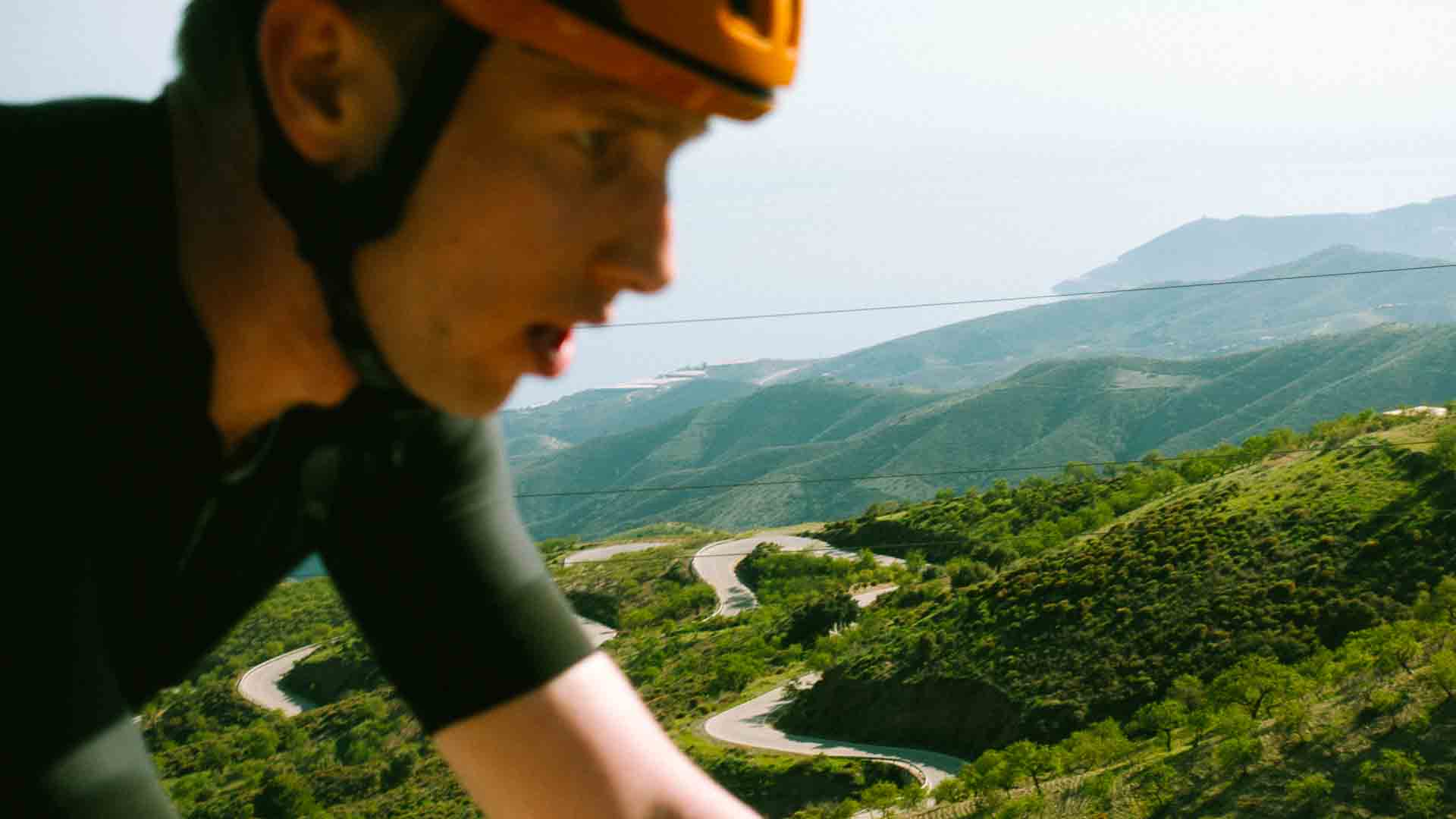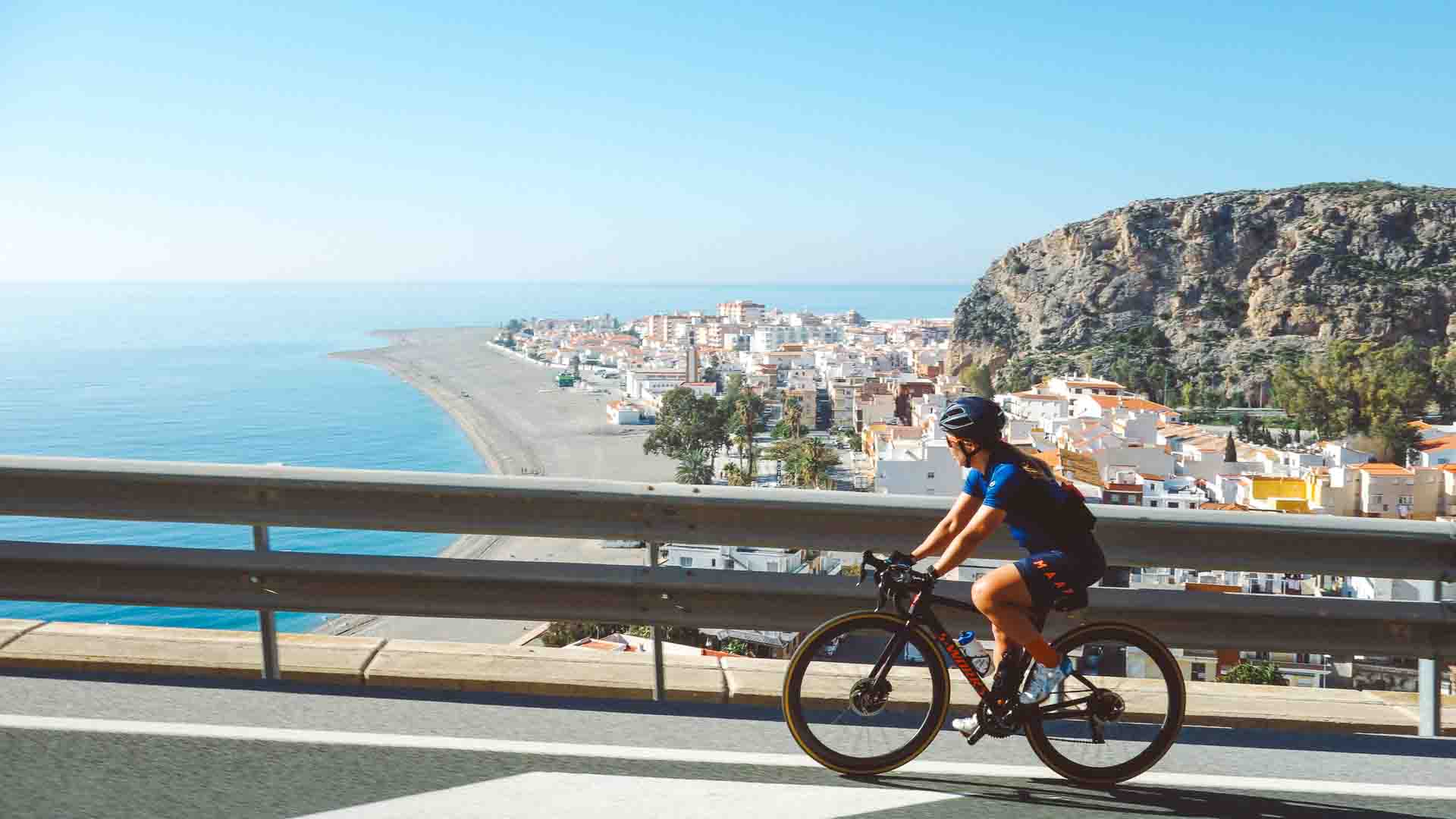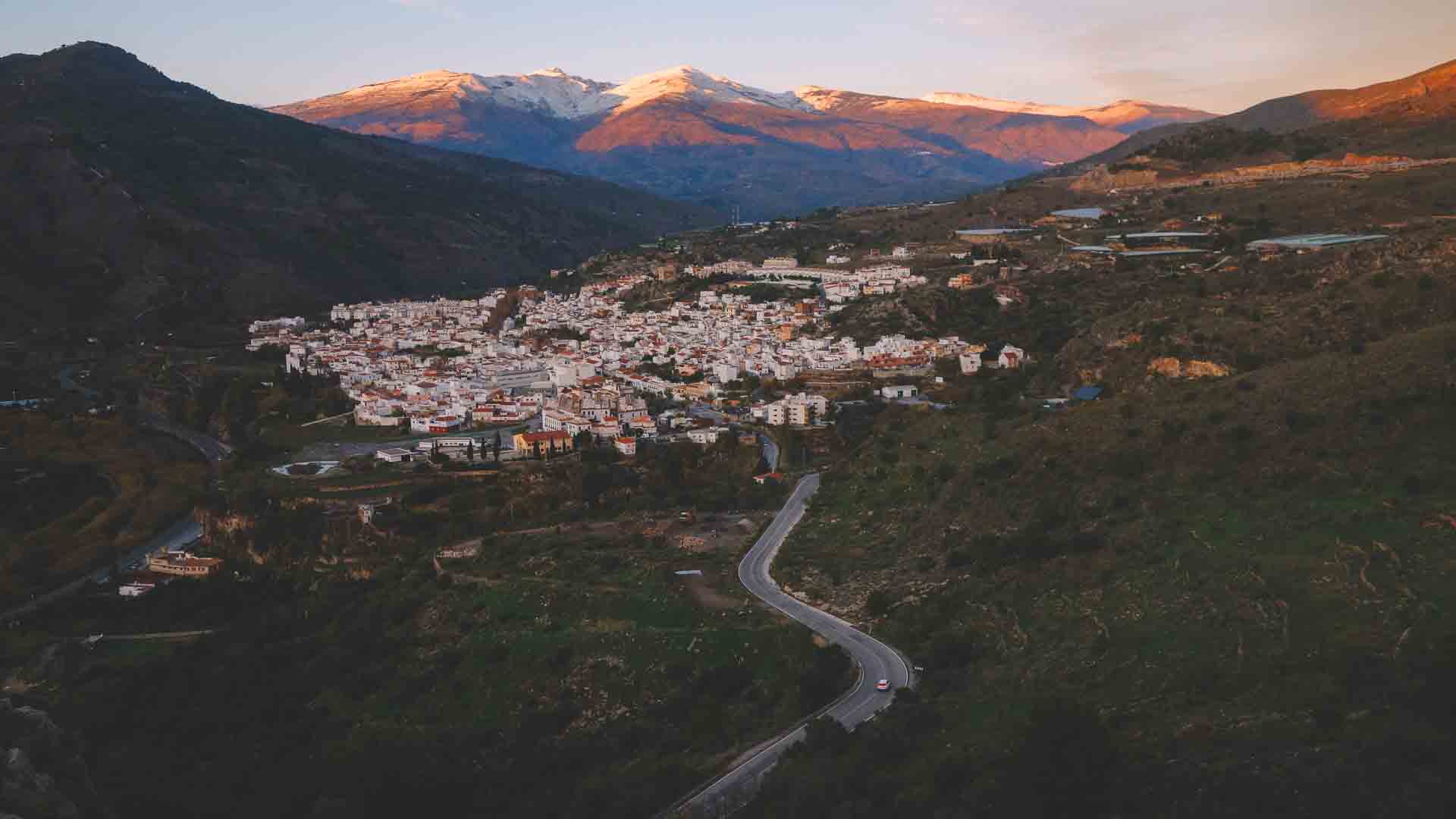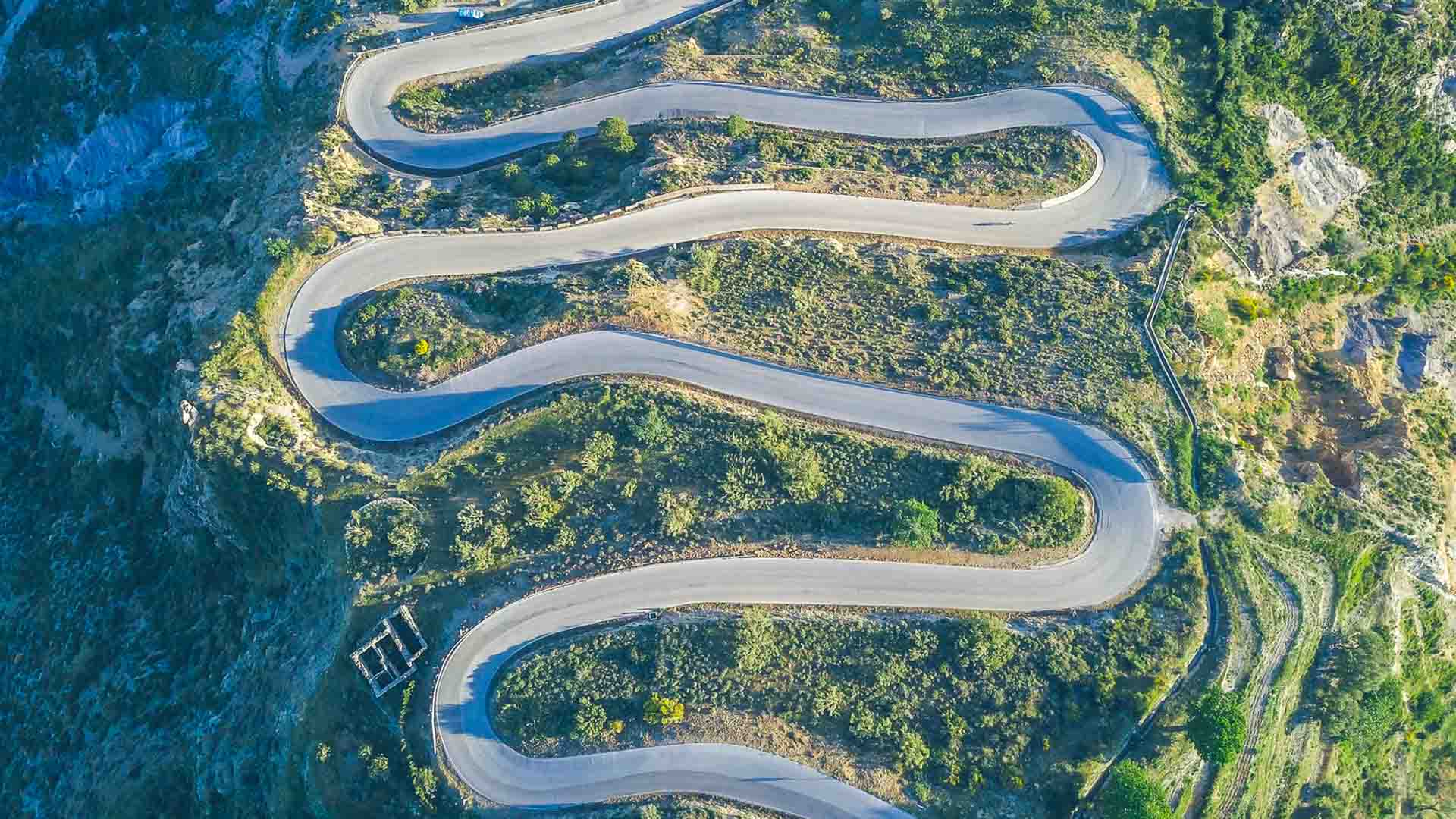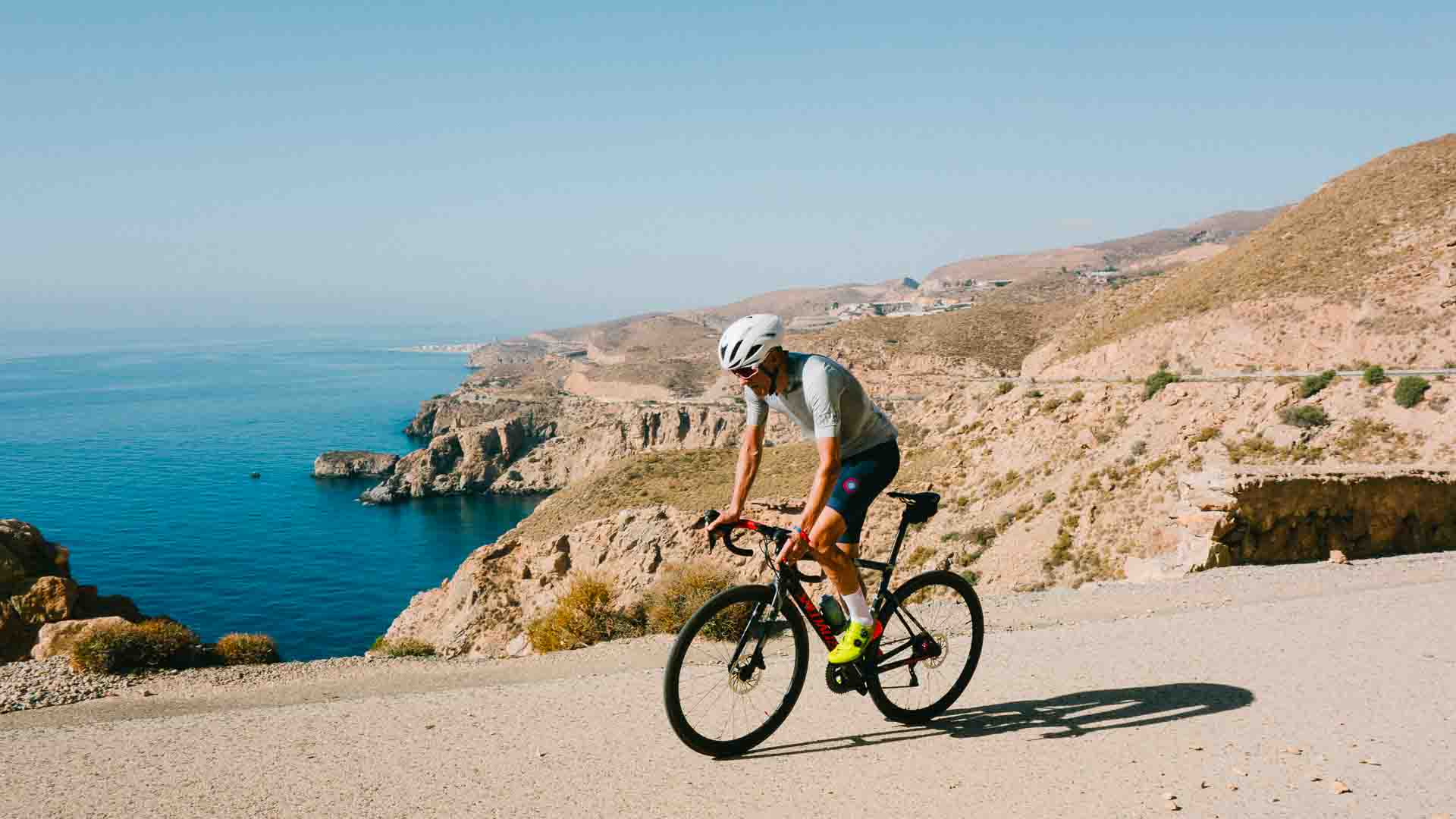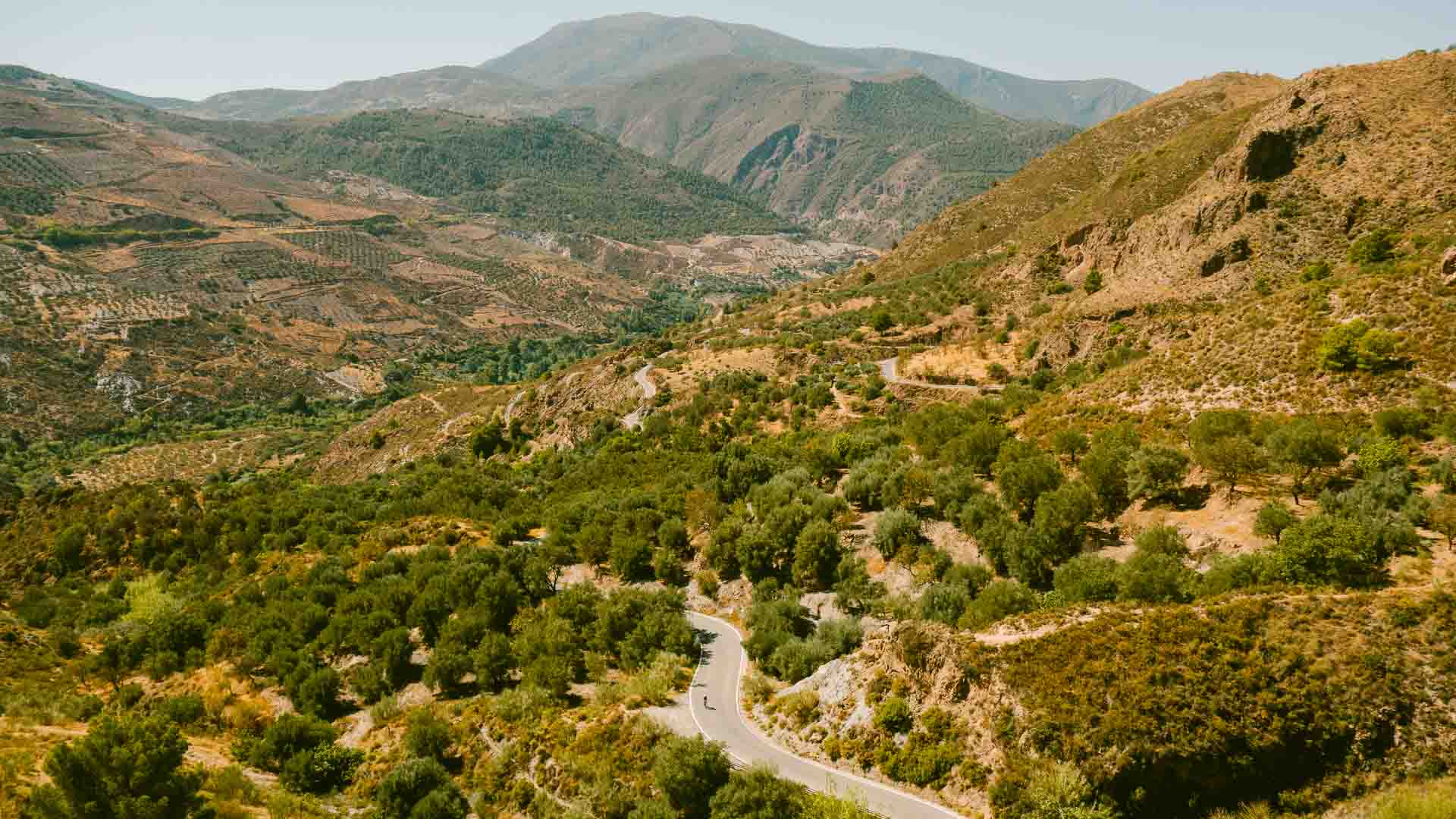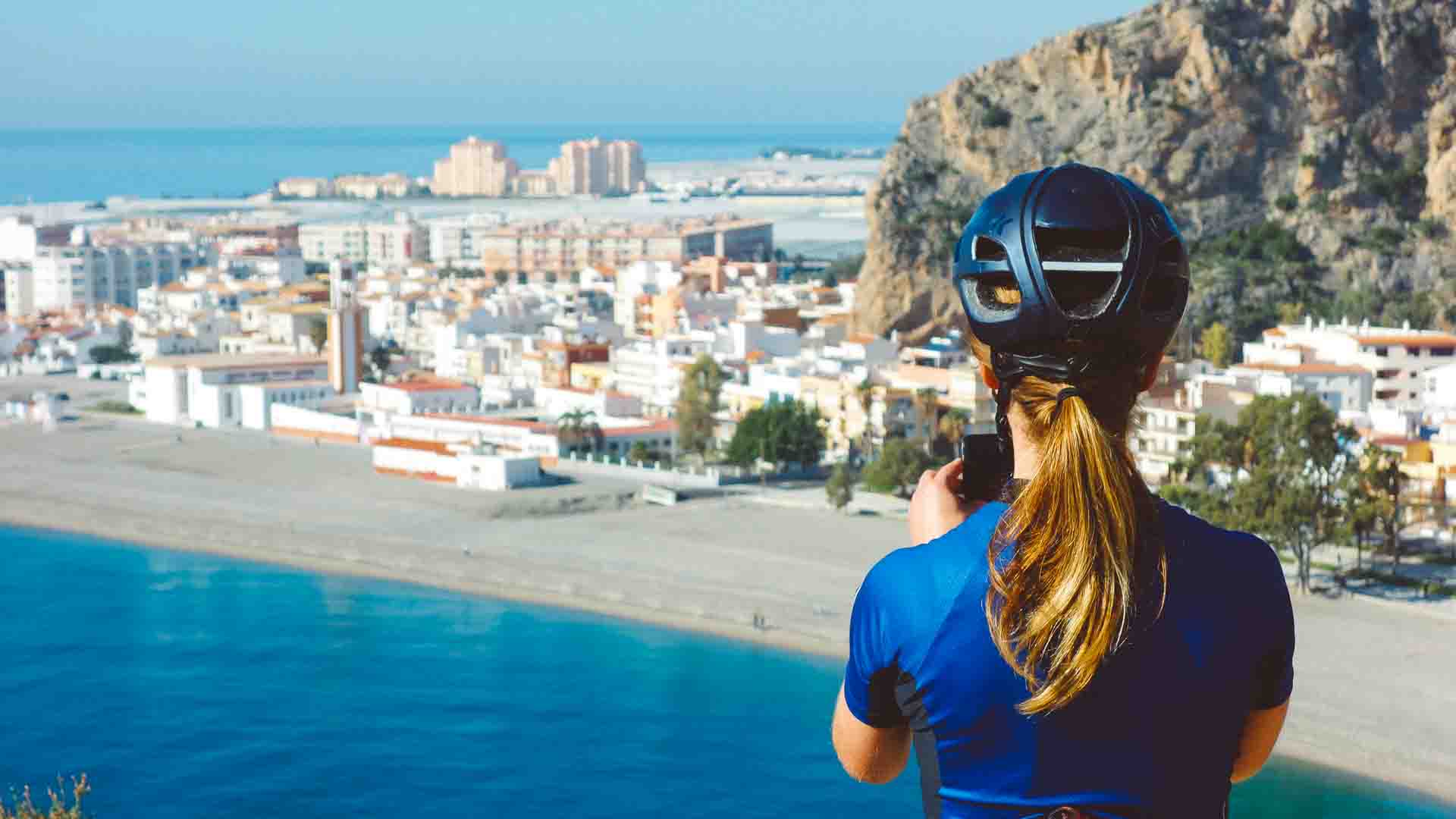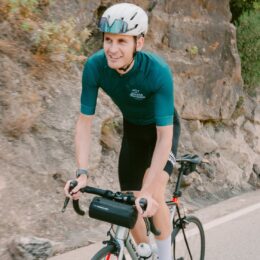Looking for a mountainous cycling paradise, with quiet roads and great off-season weather?
Heard about cycling in the Sierra Nevada, Spain and considering a trip?
This UNESCO biosphere is jam-packed with mountain panoramas, whitewashed villages and tight switchbacks. So if sunny mountain roads are your thing, this article is designed to help you plan a Sierra Nevada bike trip.
Below, we interview Matthew Armstrong, a cycling guide with Sierra Nevada cycling experts, Cycle Sierra Nevada. Matthew is adamant that the Sierra Nevada is one of cycling’s best-kept secrets. With his help, this article delves into what makes cycling Spain’s Sierra Nevada so special and why you should consider it for your next cycling adventure. Enjoy!
Want Cycle Sierra Nevada to help you plan your trip? Make sure you use the code below!
This article includes details of products and/or services that we have used ourselves or which we would consider using. Some are paid features or include affiliate links where if you click on a link and make a booking or buy something, we may earn a commission. As an Amazon Associate we earn from qualifying purchases. Please read our disclosure policy for further information.
All metrics in this article are approximate.
Why cycle the Sierra Nevada?
Cycling in the Sierra Nevada region of Andalusia, Spain, is a remarkable experience that combines breathtaking natural beauty, smooth roads, and a rich cultural heritage.
The area offers a unique blend of cycling challenges and authentic Spanish experiences. From challenging climbs to snowy mountain peaks, awesome descents, sunny Costa Tropical coastal rides and the warmth of the local culture, this region has it all for cycling enthusiasts – especially those that love to climb.
It’s these ingredients that make cycling holidays in Spain’s Sierra Nevada region so special.
What (and where) is the Sierra Nevada, Spain?
The Sierra Nevada region in Spain is a mountain range located in the southern region of Andalusia, Spain. It stretches across the provinces of Granada and Almería and is one of the most extensive mountainous areas in Europe, covering approximately 2,100 square kilometres.
The Sierra Nevada is known for its natural beauty, with snow-capped peaks, deep valleys, and picturesque landscapes. The region is home to the highest mountain in mainland Spain, Mulhacén, which stands at an impressively high 3,479 metres.
Tell us about the layout of the Sierra Nevada region (from a cyclist’s perspective)
Granada is the main gateway city to the Sierra Nevada. Famous for the Alhambra Palace and its Moorish architecture, Granada sits roughly 130 kilometres northeast of Malaga and 50-60 kilometres north of the Cycle Sierra Nevada base in Vélez de Bendaudalla.
Meanwhile, the mountain of Monachil lies southeast of Granada and is the home of Europe’s southernmost ski resort and the only ski station in Andalucía. The Sierra Nevada mountain range is characterised by picturesque Pueblos Blancos (white villages), a rich cultural heritage, and deep-rooted traditions.
To the south of Granada and the Sierra Nevada, you’ll find the stunning Mediterranean coast. This part is known as the Costa Tropical and it’s famous for its 325 days of sunshine per year. It’s dotted with well-known hotspots like Marbella and Malaga. 200 kilometres east from Malaga, you come to Almeria; 400 kilometres west and you’re in the Algarve region of Portugal.
The Sierra Nevada is served by several multinational airports, including Malaga and Granada airports. There’s more information on getting here/around, below.
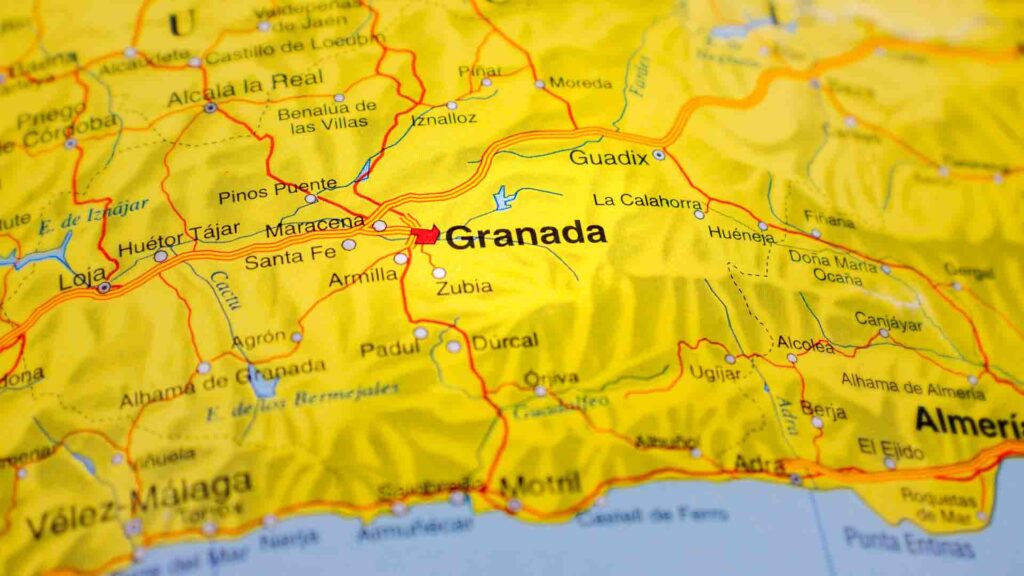
The Sierra Nevada mountains lie between Granada and the coast
What’s special about cycling the Sierra Nevada?
There’s quite a lot to say about this! You might have seen the Sierra Nevada listed in this overview of Spain and this on the best cycling destinations in Spain; here are a few of the things that puts the Sierra Nevada at the top of my cycling bucket list…
Amazing roads
The region benefits from a dense network of fabulous roads for cyclists. The roads meander over and around the hills and mountains, through awe-inspiring and unspoiled natural landscapes. Along the way you find quaint, traditional white villages, where, like something out of a film, welcoming locals are delighted to have cyclists stop by for a refreshing drink and a well-deserved rest!
In my experience, the quality of the Sierra Nevada’s road surfaces seem to increase my average speed by a few kilometres per hour. I often find myself clicking down one or two gears more than where I would usually be on the same type of terrain, simply because the rolling resistance is so low.
Courteous drivers
Cycling is popular in the Sierra Nevada. This means that if the person behind the wheel of the car behind you is not a cyclist themselves, a close family member most likely will be. For this reason, cyclists on the road are highly respected.
It is rare that we come into contact with much traffic once out of town and in the hills, but when we do, drivers are extremely used to local Spanish cyclists being on the roads.
Slow pace of life
The Sierra Nevada region has firmly held onto its roots. Guests often comment that coming here is like being transported to a time where life moves at a slower pace. The nature here is also special and as the altitudes change, so does the biodiversity, providing a total immersion.
Classic climbs
The region boasts numerous classic climbs. Each climb comes with a rich history, like La Carreta de la Cabra (The Goat’s Path), once used for transporting goods and animals from the coast over the mountains to the trading town of Granada during the cooler night hours.
Another local gem is La Venta (otherwise known as Los Guajares as it passes through one of the three Guajares villages), which features a castle perched on a hilltop. The castle once served as a watchtower and offers panoramic views of the Lecrin Valley, stretching from Granada to the coastline. Check out the La Venta Loop below.
The Trevelez climb and route, also mentioned below, is another real highlight.
And finally, no guide to the Sierra Nevada would be complete without mention of Pico Veleta, a well-known superstar of the region. The ride from Alto Hoya de la Mora to the desolate summit that stands at an incredible 3,375m is a true adventure and one done on at least 28mm tyres as the road surface towards the top is crater-like in places.
If you’re looking for a cycling experience that encompasses these and other beautiful climbs, just get in touch! And read below for more on the climbs in the region.
Cycling culture
Cycling history runs deep in Andalusia, with events catering to local cyclists and enthusiasts. The region hosts numerous events for road cyclists, where you can challenge yourself against locally famous climbs, the clock, and fellow riders.
One favourite event used to be L’Etape de Tour, starting in Granada and looping around Vélez de Benaudalla, traversing our favourite climbs and descents before returning to the city for refreshments. This event offered kits, prizes, and food stops along the route for participants. Sadly, however it seems to have been mothballed for 2024. An alternative is the Guad al Xenil sportive, which happens at around the same time as the Mallorca 312. More on this below.
Authenticity
The Sierra Nevada region exudes authenticity. Because it’s off the beaten path, it showcases an abundance of genuine charm, as it hasn’t experienced the influx of tourism that many coastal areas have.
Many families still rely on traditional farming methods and local trade to sustain their livelihoods, growing seasonal fruits and vegetables, from mangoes to oranges, olives to almonds.
The people of the Sierra Nevada lead rich lives. The locals in our spectacular region embody the “Mañana” mindset, a mentality that our guests often love to indulge in after a ride. While the region offers challenging cycling terrain, we are still in Spain, and in the afternoon, it’s customary to take advantage of siesta, followed by enjoying an al fresco dinner in the pleasant evening air.
What are the best Sierra Nevada cycling routes?
Route planning tips
Don’t underestimate the climbing
When picking the perfect roads and routes to ride in the Sierra Nevada, it’s important to be aware of elevation because the vertical gain can be very deceiving at times. 20 kilometres at home may seem like a breeze, but 20 kilometres here can be straight up!
Food, drink and mechanicals
With the region being so rural, you can easily get caught out with a lack of food and drinking water if you don’t plan your re-fuelling stops in advance. Some climbs and mountain passes are very isolated and can take hours to get over before water is available again.
Similarly, services for cyclists in Andalusia are typically found in more developed areas like Torremolinos, Malaga, and Granada; the Sierra Nevada itself is a remote region which is wonderful but can also make things tricky in the event of a mechanical.
At Cycle Sierra Nevada, we provide one of the only bike shops and bike hire facilities there is within the foothills of the Sierra Nevada themselves. A lot of our guests like to have support from us on the road.
Weather
Like anywhere, the higher you go, the more volatile the weather can become. As one of our traditional routes passes through Trevélez, the town at the highest elevation in Spain, the weather can be very different than what you started at down at sea level, especially during the winter.
The descents can also require layers. As you stop pedalling and pick up some speed, you can cool down pretty quickly. It’s always a good idea to carry warm clothes in preparation for a change in temperature while descending.
4 of the best Sierra Nevada cycling routes
Below I share some of my favourite road cycling routes in the Sierra Nevada region. These routes offer a variety of challenges and stunning views, making them ideal for cyclists looking to experience the beauty and diversity of Sierra Nevada.
All of the routes I describe are around our home base in Vélez de Benaudalla. It’s a great starting point for any cycling adventure due to the incredible choice of routes for cycling.
La Venta Loop
Essentials
Distance: 46km
Climbing: 1,200m
Notes
The La Venta loop showcases how great (and almost traffic free!) the cycling is from our base in Vélez de Benaudalla in the Sierra Nevada.
A quick, flat 5 kilometre warm-up leads to a 13 kilometre climb. When you see the castle, Torre De La Cebada, you’re almost at the top. This castle protected the passage between Granada and the coast during the Nasrid period (1230-1492).
The descent after the castle is thrilling, taking you to the town of Pinos Del Valle, a perfect spot for a coffee break. Try the Spanish omelette or tostada at Bar Venecia. At 26.5km into the ride, you’ll navigate a series of descents before returning to Vélez de Benaudalla.
Around the reservoir (plus or minus Cáñar climb)
Essentials
Distance: 61.29km
Climbing: 1,637m
Notes
This loop starts in Vélez de Benaudalla and takes you on a loop of the mountain roads around the Rio Guadelfeo reservoir.
The route starts with a steady 16km climb on a beautiful road beside Sierra Lújar mountain, leading to the Capital of the Alpujarra, Órgiva. Here you can decide whether to add on the out and back of the Cáñar climb. This includes 22 curling switchbacks, gradients up to 15% and some spectacular views over the countryside but also the switbacks you’ve just climbed.
After passing through Órgiva, there’s a 10km climb to Lanjarón, known for having the highest life expectancy in the world. It’s a good place to stop for coffee.
The ride back to Vélez de Benaudalla includes three descents; take care and enjoy!
Lujar coastal loop
Essentials
Distance: 87.36km
Climbing: 1,738m
Notes
This 87km loop offers a great mix of coastal riding along the Mediterranean plus a challenging climb with a rewarding descent. It’s a good option if you are looking for more forgiving climbs than those on offer elsewhere nearby.
The initial climb from Vélez de Benaudalla to the tunnel is a good warm-up, and the descent to Motril is worth the effort. From there you head towards the windmills you see on top of the hill, but beware it may feel like it takes a while to get there!
It’s a great descent from there towards the coast by a route that takes you through the town of Lujar. Don’t miss the family-run café Andrés Barros Ruiz on the right. While their opening hours are uncertain, if they see you waiting outside, they may open up and offer food and drinks on their terrace with amazing views. If they’re not available, Caferini in Castell de Ferro is a reliable choice for delicious tostadas. From here, you pass beautiful towns and villages near the coast and eventually reach the captivating canyon road that leads to the base of Vélez.
Tips
Bring lights as there a couple of tunnels. Consider riding clockwise as you’ll enjoy a more pleasant descent into Castell de Ferro than into Motril. There is a tight left-hand corner 43km into the loop that stands out for how sharp it is, contrasting with the rest of the descent. At around 44.25km, be aware of a grating on a right-hand corner where the road flattens out. The slats run in the same direction as you ride, which is a significant hazard as you could easily get your wheel stuck, even with wider tires.
Carreta de la Cabra (The Goat’s Path)
Essentials
Distance: 115.63km
Climbing: 2,529m
Notes
The Goat’s Path is a popular cycling route starting in Vélez de Benaudalla. It used to be a road named ‘La Carretera de la Cabra’ or ‘The Goat Highway’ because it was used by mule drivers carrying fish from the Costa del Sol to Granada. The road is now mainly used by cyclists due to a new motorway that takes most of the car traffic. The traffic-free nature of the climb makes it a winner (it’s featured in my favourite climbs below) and the steady gradient allows riders to find a good rhythm.
The ride begins with a flat 10km stretch through a canyon, followed by a rolling uphill section through Molvízar. Then there’s an enjoyable descent leading to a great coffee stop in Otívar, which is only 3km away. After that, it’s time to tackle the 23km of climb before a 8km green plateau followed, finally, by the descent back to Padul and eventually Vélez de Benaudalla.
Tips
After leaving Otívar there’s pretty much no food and water available for the next 50km until you reach Padul. It’s easy to run out of water on this climb, especially on hot days, so it’s strongly advised to refill your bottles and eat in Otívar before the climb. Restaurante Buenavista and Restaurante El Capricho in Otívar offer good tostadas. Meson Los Prados is a bar on the climb, but it may not always be open. If you want to stop for food or water after the descent, Restaurante La Abidía is a well-placed option.
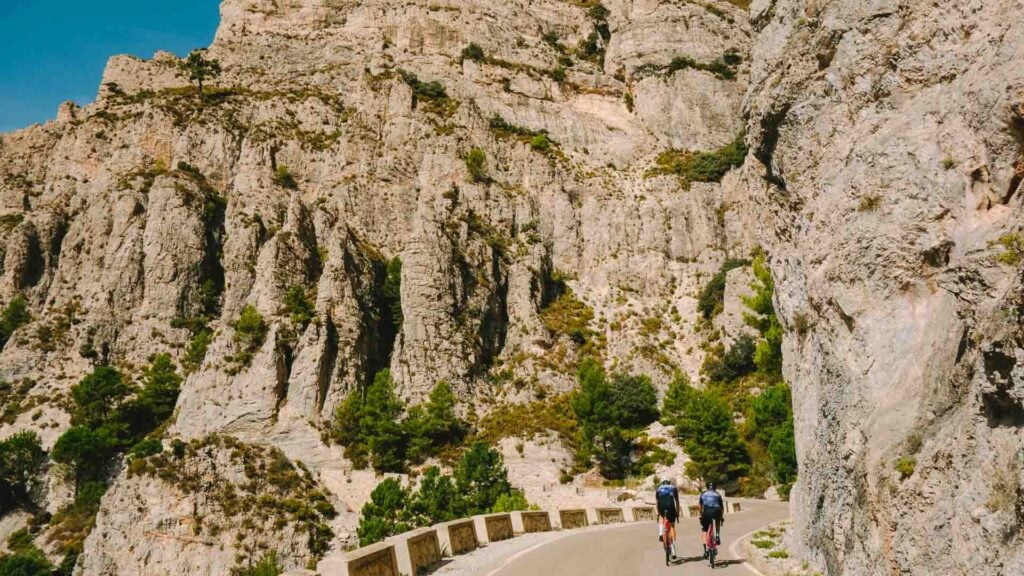
On the goat’s path (Photo credit: Cycle Sierra Nevada/Szymon Kotowski)
3 of the best Sierra Nevada cycling climbs
The Sierra Nevada’s cycling climbs are some of the best in Spain (and indeed Europe). They might not be as well-known as those elsewhere in Europe, but there is a vast selection to choose from and they have the huge advantage of not being covered in traffic.
They also benefit from great weather almost year around, due to being close to the Costa Tropical, which has the mildest winter climate in mainland Europe. This makes a lot of the climbs of the Sierra Nevada rideable throughout the year; perfect for a spot of altitude training.
There’s a reason that so many professional cyclists choose Sierra Nevada cycling training camps. Don’t be surprised to see pros on the road – teams like Garmin, Movistar, Lotto, Bora often hold training camps here.
Here are three popular climbs:
Haza del Lino (via Polopos)
- Length of Climb: 16.42 km
- Summit Elevation: 1,280 m
- Elevation Gain: 1,179 m
- Gradient (Avg): 7%
This climb is tough but the views over the snaking road and out to sea are mesmerising.
The climb up to Haza del Lino starts near the coast in the village of La Guapa (which means “The Pretty One” – spoiler alert, it’s not pretty!) and averages a gradient of 7% for almost 17 kilometres. The first couple of kilometres are quite steep, but as you leave The Pretty One behind, the gradient eases and the views improve.
You come to the charming Polopos village at around 10.5 km into the climb. The village is famous for its 16th century Arabic fortifications, wine and vineyards. There’s a cafe and water fountain here if you need them.
At the summit is the well-placed Restaurante Haza del Lino.
You can find out more info and this route includes the climb.
Trevélez
- Length of Climb: 33.6 km
- Summit Elevation: 1,486 m
- Elevation Gain: 1,007 m
- Gradient (Avg): 3%
Trevélez, sitting at 1,486 metres above sea level, is one of the highest villages in Spain. The mountain village is famous for the quality of its air-cured Iberian hams.
There are three incredible climbs to the village of Trevélez, each varying in length and gradient, but all taking in incredible stretches of quiet and scenic roads. The climb described above is the approach from Orgiva.
Gradients are forgiving throughout, and there are flat or downhill sections for recovery. You might even have energy to enjoy the valley views below! Halfway up is Pampaniera village with numerous cafés and restaurants, if you want to take a break. The steepest part of the climb is the hairpins of Pampaniera, which last only 2km and from halfway up the climb, the gradients ease so that the last four kilometres are almost flat.
You can find out more info and this route includes the climb.
Carreta de La Cabra (The Goat’s Path) climb
- Length of Climb: 36.7 km
- Summit Elevation: 1,332 m
- Elevation Gain: 1,304 m
- Gradient (Avg): 5%
This is probably the most spectacular climb in the area. From the seaside town of Almunecar, the climb involves 36 kilometres of steady climbing averaging 5% gradient which includes some downhills scattered throughout the climb and a slightly steeper last couple of kilometres. The top of the climb sits at 1,358 metres above sea level and the views back down the valley and over the switchbacks are fantastic.
In the past, the road was used by mule drivers taking fish from the coast to the markets in Granada city, taking almost two days and traversing the mountain at night to avoid the daytime sun.
You can find out more info and it’s also included in our routes above.
Want help organising your Sierra Nevada cycling trip?
We’ve been planning cycling holidays in the Sierra Nevada since 2013 and would love to help you plan yours. We know all the best routes in the region and can put together an itinerary to suit you.
Use code EpicRR5 when you book with us and we’ll give you 5% discount on any services you book.
What are the best Sierra Nevada cycling events?
If you’re interested in watching or participating in cycling events, the Sierra Nevada region has some fantastic options:
Vuelta España
The Vuelta a España, also known as the Tour of Spain, is one of the three Grand Tours of cycling, alongside the Tour de France and the Giro d’Italia. It starts in mid August each year.
While the Vuelta España features stages all across Spain, it often includes challenging mountain stages in the Sierra Nevada region. This prestigious event attracts top cyclists from around the world and offers cycling enthusiasts the opportunity to witness professional riders tackle the stunning mountain roads of Sierra Nevada.
Vuelta de Andalucía
The Tour de Andalucía, also known as the Ruta del Sol, is a professional road cycling stage race. It takes place each year in February.
While the race does not exclusively take place in Sierra Nevada, it often includes stages that traverse the beautiful landscapes of this mountainous area. It’s a great event to follow if you’re interested in watching professional cycling in the region.
L’Etape de Tour Granada Gran Fondo Event
L’Etape de Tour is a series of long-distance cycling events held around the world, allowing amateur cyclists to experience the thrill of riding on closed roads, similar to professional races like the Tour de France.
They offer cyclists the chance to ride challenging routes, and enjoy the unique atmosphere of a Gran Fondo event while exploring the stunning terrain and scenery of a particular part of the world. The Granada Gran Fondo event was part of this series and used to regularly take place in the Sierra Nevada region. However, for 2024, it seems it’s no longer happening; hopefully it will be back soon!
Gran fondo Guad al Xenil
The GF Guad al Xenil takes place on 21 April 2024, from Loja near Granada. It’s a 139 kilometre course with 2,600 metres of climbing and fully closed roads.
If you’re looking for an alternative to Mallorca 312, this could be it! Cycle Sierra Nevada run a three night break over the gran fondo weekend. More information here.
Where to stay in the Sierra Nevada?
There aren’t many cycling-specific hotels in the Sierra Nevada, but the hotels below offer great facilities and accommodation for cyclists in the region.
Remember to double-check accommodation bike storage arrangements (and any other services you need) before booking as policies often change.
Hotel la Ventera
Hotel La Ventera, in the village of Gualchos, stands out for its cyclist-friendly amenities and atmosphere.
We love
- BMC bike rentals: Hotel La Ventera partners with Cycle Sierra Nevada to offer BMC bike rentals. This means you can conveniently rent high-quality bicycles for your cycling adventures.
- Guided tours: They also provide guided tours, allowing you to explore the stunning Sierra Nevada region with experienced guides who know the best routes and attractions.
- Fresh local meals: At Hotel La Ventera, you can enjoy fresh and locally sourced meals prepared in-house. It’s essential fuel for your cycling endeavors.
- Cycling culture: The hotel embraces cycling culture throughout its premises. From the names of the rooms to the cycling-themed decor on the walls, you’ll feel the passion for cycling everywhere.
- Coffee shop: They even have a coffee shop open on weekends, perfect for pre-ride fueling and for anyone passing by the area.
Be aware
- Dinner: You need to book dinner with the team in advance – there’s no 24/7 restaurant!
- Rooms: They only have five rooms, sleeping just 12 guests. So book early!
Hotel Alcadima
Hotel Alcadima is a family run hotel in the village of Lanjaron in the southeastern Sierra Nevada.
We love
- Swimming pool: The swimming pool is fabulous and set in a lovely garden full of fruit trees.
- Bike storage and workshop: These services make life easier for us cyclists.
Be aware
- Terrace: Many of the rooms ahve a private terrace/balcony, but check which room category you book.
- Views: The rooms overlooking the valley have amazing views.
Hotel Taray Botanico
Hotel Taray is located just outside Orgiva, halfway between the Sierra Nevada and the Costa Tropical.
We love
- Swimming pools: There are two; one for adults and one for kids, surrounded by olive and fruit trees.
- Gardens: Spacious lounges offer plentiful seating to admire the incredible views of the Sierra Lújar mountains.
Be aware
- Pool opening: The pool is not open year around; check before you book.
- Location: The hotel is not in the town of Orgiva, it’s around 2 kilometres down the road.
Alpujarra Secret
Alpujarra Secret is an aparthotel with 17 modern apartments in the village of Orgiva.
We love
- Good for groups: The different apartments sleep between two and four people and are spacious.
- Facilities: You might be in town but you still have access to a jacuzzi, gym and communal terrace.
Be aware
- Cooking: There may be no restaurant in the hotel, but you have your own kitchenette.
What should we know about bike hire and bike shops in the Sierra Nevada?
Prices, services and bike brands often change. Please let us know if anything is incorrect.
In the Sierra Nevada region, bike rental options vary depending on your location within the region. Here’s an overview:
Coastal areas
Along the coastal towns such as Motril, Nerja, Almunecar, and La Herradura, you can find numerous bike rental shops.
These areas cater to both locals and tourists and offer various bike rental options.
Inland
At Cycle Sierra Nevada, we offer BMC bike rentals, nutrition, kit, and some of the best coffee in Andalusia! We have full-time English-speaking mechanics on-site and our rental bikes are always the newest models every year from the BMC line-up. Our bikes are prepared by professional mechanics, with measurements tailored to your needs, making them ready for your arrival.
If you’re not staying in the village we’re based in, Vélez de Benaudalla, we can deliver rental bikes delivered to your chosen location within the region.
Tips for bike shops in the Sierra Nevada
Keep in mind that once you head inland, bike shops are scarce, especially as you venture into the hills. It’s advisable to carry essential supplies like multiple spare tubes, a chain link, a hand pump, a multi-tool, and anything else you might need on the road, as finding a bike shop might not always be easy in remote areas.
Book your bike in advance, particularly in peak season when bike rental in the Sierra Nevada can get busy.
Remember to bring your own pedals, shoes and helmet. This packing list may help!

Cycle Sierra Nevada – bike shop and great coffee too! (Photo credit: Cycle Sierra Nevada/Szymon Kotowski)
What’s the best time to visit for cycling Sierra Nevada?
The best months for cyclists to visit the Sierra Nevada are typically from early September to late May; this is cycling season here.
During this period, the weather is pleasant for cycling, with milder temperatures and plenty of sunshine. It’s a perfect escape from the shorter and colder days experienced in many parts of northern Europe during the winter.
The summer months of June to August are less popular amongst cyclists. Temperatures start to heat up in June and around Granada city are frequently 40C+ in July and August. However, along the coast and in the mountain villages on the southern side of the Sierra (including our base at Vélez de Benaudalla) it’s typically around the mid 30s with much cooler nights.
A final note: if you plan to conquer the Pico de Veleta, the highest paved road in Europe, it’s crucial to monitor the weather carefully. Winter conditions can make the climb inaccessible by bike, as it becomes a ski resort area.
Want help organising your Sierra Nevada cycling trip?
We’ve been planning cycling holidays in the Sierra Nevada since 2013 and would love to help you plan yours. We know all the best routes in the region and can put together an itinerary to suit you.
Use code EpicRR5 when you book with us and we’ll give you 5% discount on any services you book.
Tips for cycling the Sierra Nevada?
Respect the mountains
Safety in the Sierra Nevada relies on respecting the mountainous terrain. Be prepared for rapid changes in weather and temperature as you cycle through various elevations.
Highway code and travel information
As ever, it’s a good idea to check current travel information before you book and travel. For UK visitors, the UK government travel information pages for Spain are here.
You should also read and follow Spain’s highway code.
Physical fitness
The region’s roads can be challenging, so being in decent shape is important. Ensure you can handle the climbs and are confident descending on mountain roads.
Local cuisine
The food in the Sierra Nevada is exceptional. Tapas bars are abundant, offering local meats, cheeses, and fresh bread. If you have a gluten allergy, consider trying a traditional Spanish potato and egg tortilla, which is often available at most bars and cafes.
Another fantastic thing about this part of Spain is that, however hard you try, your bar bills are unlikely to be too eye-watering. It’s a very reasonably priced place to eat and drink.
Language
While more populated areas have English speakers, it’s helpful to know some basic conversational Spanish, especially in less touristy regions. Ordering food and drinks is a primary task when cycling, and a few Spanish phrases can go a long way in ensuring the food that arrives is what you expected!
How do we get to the Sierra Nevada?
Malaga Airport
Many tourists choose to fly into the international airport at Malaga. Malaga is a significant city in proximity to the Sierra Nevada. However, to fully immerse yourself in the Sierra Nevada, it’s advisable to drive approximately one to one and a half hours east to reach the mountains. This journey allows you to enter the heart of the region from the small town of Motril.
Granada Airport
Granada airport is another popular choice. From the UK, Easyjet, Iberia and British Airways all fly here.
Airport transfers
Cycle Sierra Nevada offers convenient airport transfer services from both Malaga and Granada airports. This is particularly beneficial for cyclists, as they can transport bike boxes and gear.
How can cyclists find out more about Cycle Sierra Nevada?
If you’re planning a cycling holiday to the Sierra Nevada, get in touch with us.
The Cycle Sierra Nevada bike shop warmly welcomes both locals and tourists. We provide BMC bike rentals, ride fuel, nutrition, kit, and coffee. We can also help you plan self-guided and guided cycling trips in our region. Just get in touch!
Use code EpicRR5 when you book with us and we’ll give you 5% discount on any services you book.
Final thoughts
So, why should cyclists visit the Sierra Nevada? The answer is simple: for an unforgettable cycling adventure that combines the best of nature, culture, and the joy of the open road.
Plan your trip, hop on your bike, and discover the magic of cycling in the Sierra Nevada.
Got a question for Cycle Sierra Nevada?
Fill out this form and Cycle Sierra Nevada will reply (within 24 hours wherever they possibly can!)
Got a question for Matthew?
Fill out this form and we will send it to Matthew. We aim to get you an answer within 24 hours wherever possible!
The contents of this website are provided for general information purposes only. It is not intended to amount to advice and you should not rely on it. You should carry out your own due diligence and risk assessments and take professional advice. Views expressed by interviewees or other users of this website do not necessarily represent our views. We make no representations, warranties or guarantees, whether express or implied, that the content on our website is accurate, complete or up to date. If you use any information or content on this website, download from, or otherwise obtain content or services through our website, it is entirely at your own discretion and risk. Epic Road Rides Ltd disclaims all liability and responsibility arising from any reliance placed on the information and content on this website. Find out more here.
Want help organising your Sierra Nevada cycling trip?
We’ve been planning cycling holidays in the Sierra Nevada since 2013 and would love to help you plan yours. We know all the best routes in the region and can put together an itinerary to suit you.
Use code EpicRR5 when you book with us and we’ll give you 5% discount on any services you book.


